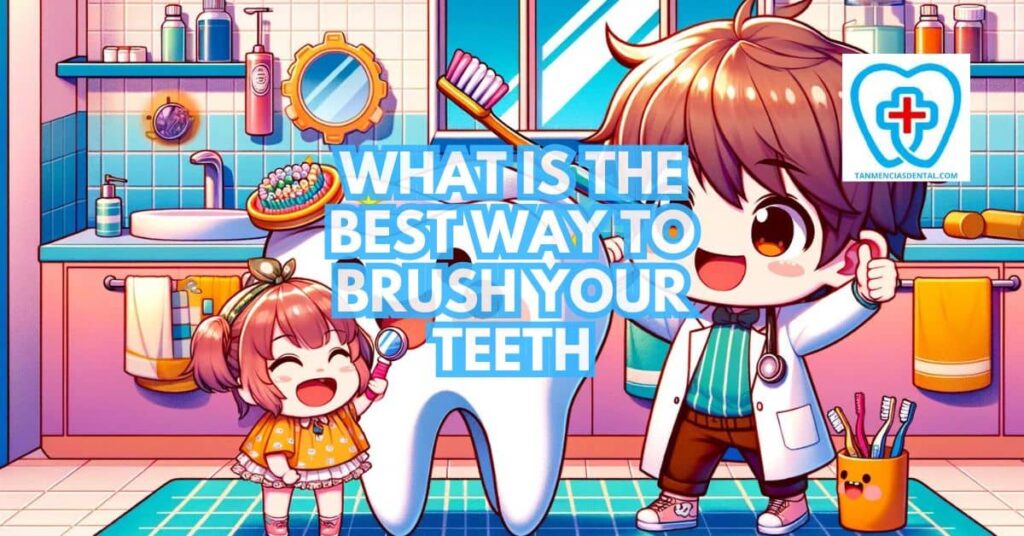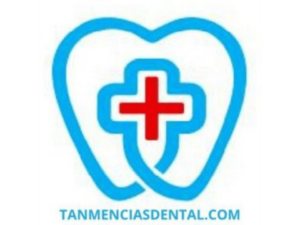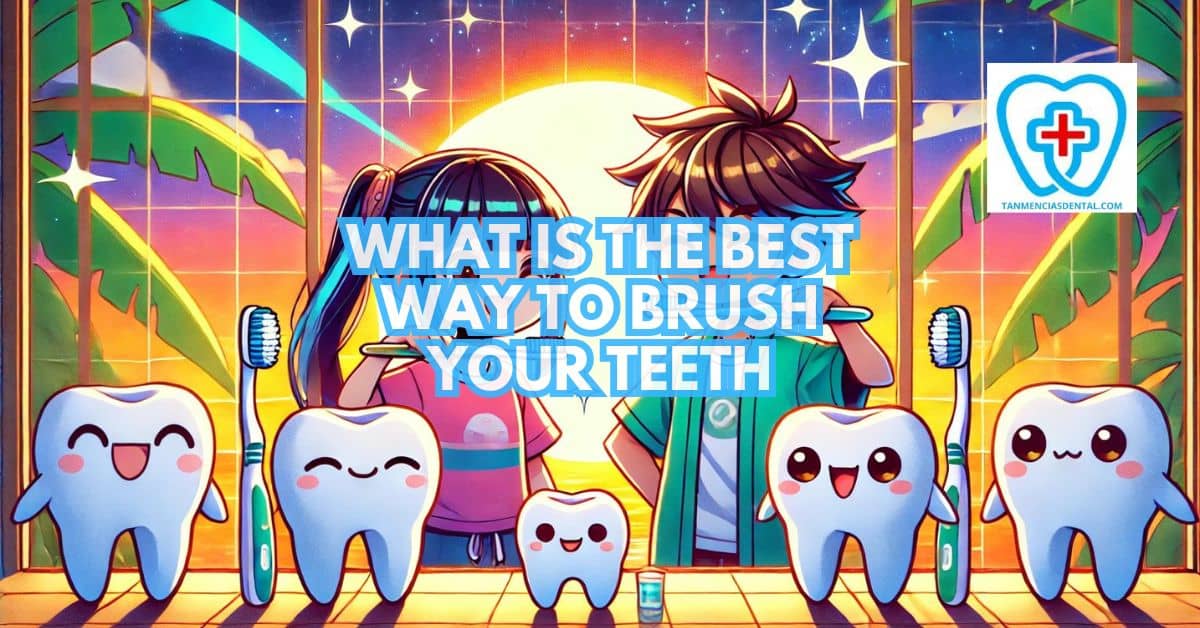Understanding what is the best way to brush your teeth is key to keeping your teeth and gums healthy, which is important for overall health.
It not only helps in preventing cavities but also in protecting against gum disease and promoting fresh breath.
Proper brushing techniques can significantly reduce the buildup of plaque, a sticky film of bacteria that forms on teeth.
Effective brushing covers all tooth surfaces, including hard-to-reach areas that are prone to decay.
Our goal is to help you learn the best way to brush your teeth for optimal dental care.
1. Understanding the Need to Brush: A Closer Look at Oral Care Practices
To properly brush your teeth, it’s important to clean all surfaces of the teeth, including the outside, chewing, and inside surfaces, which are often neglected.
Regular brushing helps remove food particles and plaque before they harden into tartar, which can only be removed by a hygienist or dentist.
If you fail to properly brush your teeth, it can lead to serious dental problems like cavities, gum disease, and even tooth loss, which may impact your overall health.
Additionally, poor oral hygiene can increase the risk of infections that spread from the mouth to other parts of the body.
To prevent these issues, it’s essential to brush twice daily using proper techniques and to visit a hygienist regularly for cleanings.
Understanding how to properly brush your teeth is the foundation of a good oral hygiene routine.
With consistent care, you can protect your teeth and gums, enhancing both your health and confidence.
🦷 Can Dentists Prescribe Medication? Uncovering the Limits of Dental Prescriptions
2. Choosing the Right Toothbrush and Toothpaste: The First Step in Effective Oral Care
Selecting a toothbrush with soft bristles is recommended to avoid damage to the gums and tooth enamel.
The size of the toothbrush head should allow easy access to all areas of the mouth, ensuring no spot is missed during cleaning.
Fluoride toothpaste is advisable for most individuals as it helps to strengthen tooth enamel and prevent decay.
Toothpaste comes in various formulations catering to different needs, such as sensitivity, whitening, and gum care, making it important to choose one that suits your specific dental health needs.
Together, the right toothbrush and toothpaste form a fundamental duo in the daily battle against dental diseases.
🦷 The Surprising Benefits of Electric Toothbrushes You Need to Know
3. The Importance of Frequency of Brushing: Finding the Balance
Understanding the importance of toothbrushing is crucial for maintaining oral health and preventing dental issues.
Dentists recommend brushing at least twice a day, in the morning and before bedtime, to effectively manage plaque and safeguard against gum disease and decay.
Toothbrushing after each meal is particularly beneficial, as it helps remove food particles that contribute to plaque buildup.
However, it’s important to avoid brushing immediately after consuming acidic foods to prevent enamel erosion, highlighting the significance of timing in your oral care routine.
For those at a higher risk of dental problems, a dentist may advise additional brushing sessions to target plaque and protect the chewing surfaces of the teeth, which are prone to decay.
Striking the perfect balance in the frequency of tooth brushing is essential, as it ensures that teeth and gums are kept clean without causing damage.
By adhering to these guidelines, individuals can enjoy the benefits of a healthy mouth, demonstrating the critical role of tooth brushing in oral hygiene.
🦷 Can Dentists Prescribe Antibiotics? A Deep Dive into Dental Prescription Powers
4. Mastering the Proper Brushing Technique: The Key to Thorough Cleaning
Mastering the proper brushing technique is essential for maintaining oral health and ensuring that your efforts yield the best results.
Here are some valuable tips on brushing your teeth the right way to enhance the effectiveness of each session.
First, adopting a gentle, circular motion while brushing, especially along the gum line, is critical for removing plaque effectively without causing any irritation or harm.
Positioning the brush at a 45-degree angle against the gums maximizes the brush’s contact with both the tooth surface and the gum line, facilitating a more thorough cleaning process.
It’s recommended to allocate at least two minutes for brushing, giving you sufficient time to meticulously clean each section of your mouth, including the hard-to-reach areas.
This careful and methodical approach not only ensures the removal of plaque and food particles but also significantly reduces the risk of developing tooth decay and gum disease.
Emphasizing the correct technique over simply brushing more frequently can make a significant difference in your oral hygiene routine, underscoring the importance of how you brush your teeth, not just how often.
🦷 Conquering Your Fear of Brushing: Tips for a Stress-Free Routine

5. The Benefits of Using a Tongue Scraper for Enhanced Oral Hygiene
Integrating a tongue scraper into your daily oral hygiene routine can significantly enhance your overall dental health.
This simple tool is designed to remove bacteria and food particles that accumulate on the surface of the tongue, which often contribute to bad breath and an unpleasant taste in the mouth.
By effectively clearing away these residues, a tongue scraper helps to freshen breath and improve the cleanliness of your mouth.
Removing the buildup on the tongue can enhance your taste sensation, as layers of debris that may dull your taste buds are cleared away.
Using a tongue scraper is a quick and easy addition to your brushing and flossing routine, offering a more comprehensive approach to oral care by addressing areas that may otherwise be missed.
🦷 Naming Your Dental Clinic: Key Tips for Standing Out and Avoiding Mistakes
6. What Is the Best Direction to Brush Your Teeth? Enhancing the Cleaning Process
The best way to brush teeth involves employing circular or vertical strokes, which have been shown to be more effective in removing plaque and food particles than horizontal brushing.
This approach not only targets the hard-to-reach areas but is also gentle on the gums and enamel, minimizing the likelihood of gum recession and enamel erosion.
By starting at the gumline and brushing towards the edge of the tooth, this method ensures that debris is swept away efficiently.
It’s crucial to focus on one section of your mouth at a time, allowing you to thoroughly clean each tooth surface without missing any spots.
Moreover, remember to brush your tongue, as it can harbor bacteria that contribute to bad breath and other oral health issues.
Incorporating these strokes to brush your teeth, along with the specific direction recommended, can significantly elevate the effectiveness of your daily oral hygiene routine.
Adopting this directional brushing method, therefore, represents a simple yet impactful adjustment to enhance the cleanliness of your mouth and the health of your teeth and gums.
🦷 How to Fix a Broken Tooth at Home: Quick Relief Tips Before Your Dentist Visit
7. The Role of an Electric Toothbrush in Oral Hygiene: A Technological Advantage
Electric toothbrushes offer a superior cleaning experience through their advanced design and functionality.
The oscillating or vibrating bristles of an electric toothbrush can more effectively break down plaque and reach difficult areas such as the back molars.
Many models feature timers to ensure users brush for the full two minutes, promoting thorough cleaning.
Electric toothbrushes can be particularly beneficial for individuals with limited manual dexterity, such as the elderly or those with certain disabilities.
Incorporating an electric toothbrush into your oral care routine can enhance plaque removal and improve gum health with minimal effort.
🦷 Could Skipping Brushing Really Make You Sick? The Truth Revealed
8. Incorporating Flossing and Mouthwash: Complementing Your Brushing Routine
Flossing daily is essential for removing plaque and food particles from between the teeth—areas that a toothbrush cannot reach.
It helps prevent the development of cavities and gum disease by eliminating plaque buildup in the interdental spaces.
Using mouthwash as part of your oral care routine can further reduce bacteria in the mouth, offering additional protection against gum disease and tooth decay.
Choosing a mouthwash with fluoride can provide extra support for strengthening tooth enamel and preventing cavities.
Together, flossing and mouthwash complement brushing by targeting areas and issues that brushing alone may miss, rounding out a comprehensive oral hygiene regimen.
🦷 Why Your Broken Tooth Filling Might Fail: Common Causes and How to Prevent Them
9. Exploring Brushing Without Toothpaste: An Unconventional Approach
Brushing without toothpaste, especially as an additional clean during the day, can still be effective in removing plaque and food particles.
This method stimulates the gums and reduces the buildup of plaque through mechanical action.
It’s particularly useful when you need to freshen your mouth but don’t have toothpaste handy.
However, using fluoride toothpaste at least twice a day remains crucial for preventing tooth decay and strengthening enamel.
This approach should not replace regular brushing with toothpaste but can serve as an adjunct for maintaining oral hygiene throughout the day.
🦷 Why Dentists Might Be Happier Than You Think: Insights and Surprises
10. Addressing Common Mistakes in Oral Care Practices: Learning From Errors
One common mistake is brushing too aggressively, thinking it leads to cleaner teeth, but it can actually cause gum recession and enamel wear.
Another error is neglecting the tongue, which can harbor bacteria leading to bad breath and other oral health issues.
Skipping flossing is a widespread oversight, yet flossing is essential for removing plaque between teeth where a toothbrush can’t reach.
Ignoring the recommended two-minute brushing time reduces the effectiveness of each brushing session.
Recognizing and correcting these errors are pivotal steps in improving oral hygiene and ensuring comprehensive care for your mouth.
🦷 Breaking Down the Cost of Broken Tooth Repair: What to Expect Before Your Appointment
11. Regular Dental Checkups: The Professional Perspective on Your Brushing Habits
Regular visits to the dentist for checkups and cleanings play a critical role in maintaining oral health.
These appointments allow professionals to identify and address issues before they become severe, such as cavities or gum disease.
Dentists can also provide personalized advice on brushing techniques and oral hygiene practices based on their observations of your mouth’s condition.
Professional cleanings remove tartar buildup, which is impossible to remove with brushing alone.
Incorporating the feedback and advice from dental professionals ensures that your brushing habits are as effective as possible, safeguarding your dental health.
🦷 Dental Hygiene for Kids: Fun Tips for Sparkling Smiles and Happy Brushing Adventures
👨⚕️ Conclusion
Adopting the proper way to brush your teeth is a simple yet profound step toward ensuring lifelong dental health.
By choosing the right tools, mastering the correct technique, and complementing your routine with flossing and mouthwash, you set a solid foundation for oral hygiene.
Regular dental checkups provide professional oversight to refine your practices further.
Remember, the health of your mouth mirrors your overall health, making effective brushing a vital part of daily self-care.
Embrace these principles and enjoy the benefits of a healthy, radiant smile for years to come.
😁 Self-Promotion
Visit Tan-Mencias Dental Clinic in Parang, Marikina City, where we prioritize your smile and dental health with the utmost care and professionalism.
Our friendly team is always ready to provide you with personalized and expert dental services, ensuring a comfortable and positive experience every time.
For any questions or concerns, feel free to call us at 9171451074, leave a message on our Facebook page, or contact us via our website’s contact page.
We’re dedicated to making your visit as convenient and stress-free as possible.
Let us be a part of your journey to a healthier, brighter smile.
We look forward to welcoming you to the Tan-Mencias Dental Clinic family!

